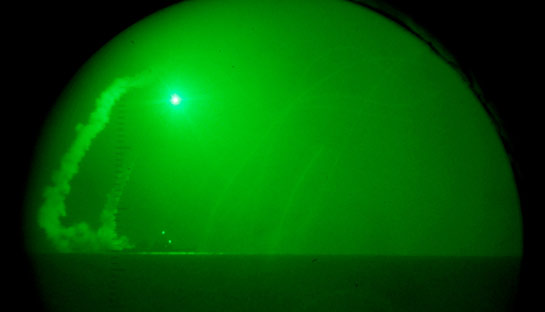A War of Images

There’s a war of images going on - along with the actual war. You probably already noticed. “Operation Odyssey Dawn” - the bombing of Libya - started with the now almost obligatory photographs of cruise missiles launched from US warships far away. Here is a gallery of the first images. Have a look at the credits - many of the images are courtesy of the military (as far as I could tell - sampling whatever was on display at Detroit airport yesterday - most US newspapers featured one of those images on the front page). In addition, you got the photojournalists on the ground, taking the usual photographs: Burning tanks, fighters striking poses, etc. And then you have the photography amateurs, meaning civilians and soldiers alike. Everybody is taking photographs, everybody is trying to shape the message. (more)
The amateurs’ photographs for the most part are seen in less official contexts. Amateurs have Flickr sites, but unlike the military they don’t send out press releases. But there is one striking case where photographs taken by participants of war have huge repercussions. I’m thinking of the photographs coming out of Abu Ghraib, and now there is a new set of such images, coming out of Afghanistan. German news magazine Der Spiegel published images of US soldiers posing with the corpses of innocent civilians they killed.
In the end who will win the war over the message (or meaning) will be decided by who picks the images for the front pages of newspapers and websites: Which images will we see, which ones will we not see? Of course, we will be able to see more images than just those on the front pages. There are the many official and unofficial image galleries on websites. Whether or not those galleries will contribute to what the final message is going to be I don’t know. Right now, based on what I’ve seen over the past decade, I doubt it. For example, we all have seen the Abu Ghraib photographs, and many of us know that the actions in the prison can be traced down from orders given at the top, but the “bad apple” explanation is still the one most widely accepted.
I’ve spent the last few weeks trying to investigate one question: How much of a modern war can I piece together and/or infer from the images I can access online? I don’t know what the answer is, yet. I know I can figure out much more than I thought, but the more I look the more there is, and where this all is going I don’t know. What I know, though, is this: The idea that the number of images we get is proportional to how well we are informed is not true at all.
Update (22 March 2011): David Campbell on “emotional optics”.